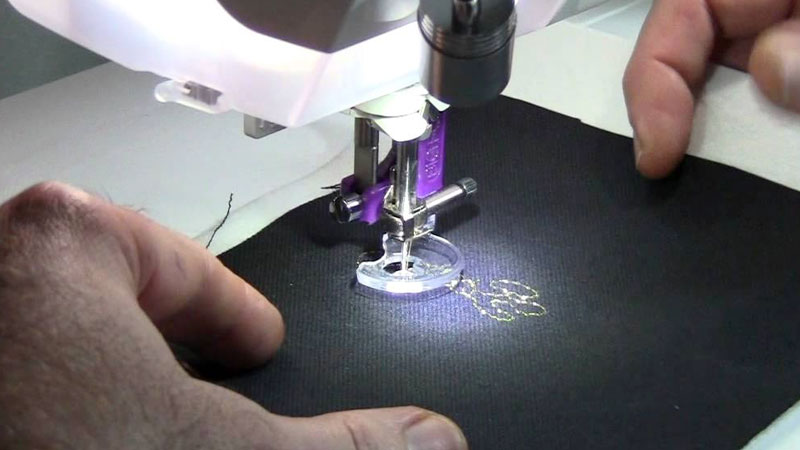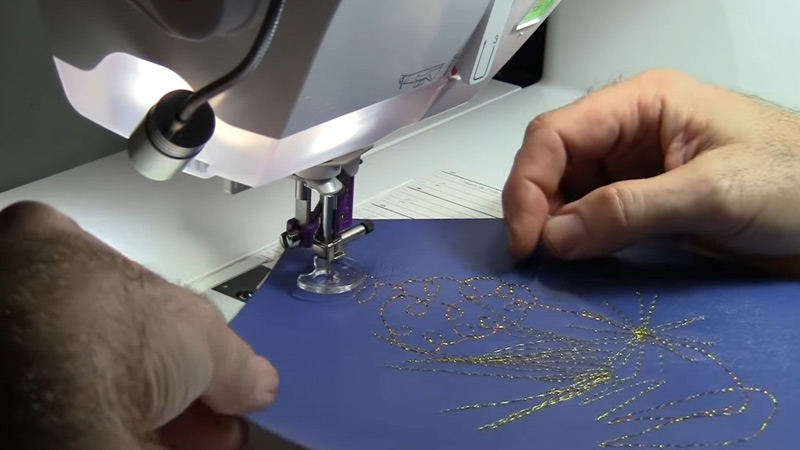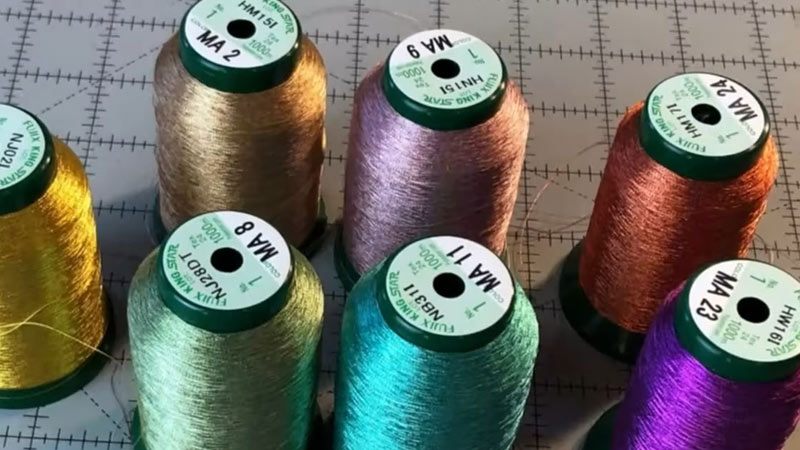Embarking on a sewing project that involves metallic thread can be an exhilarating endeavor, adding a touch of shimmer and sophistication to your creations.
However, working with metallic thread presents unique challenges, with its propensity to unravel or snap during stitching.
To ensure a seamless sewing experience and stunning outcomes, your choice of sewing needle becomes paramount. In this guide, we will delve into the intricacies of selecting the ideal sewing needle for metallic thread.
From needle size to type, shape, and material, we’ll explore every facet of needle selection to help you navigate the often tricky path of working with these dazzling, yet sometimes temperamental, threads.

What Sewing Needle Should You Use for Metallic Thread?
When working with metallic thread for sewing machine projects, selecting the right sewing needle is crucial for achieving the best results.
Metallic threads can be quite challenging to work with due to their unique properties, such as their tendency to fray and break more easily than regular thread.
Choosing the appropriate needle can help you minimize these issues and ensure a smooth sewing experience.
Here’s a guide on what sewing needle to use for metallic thread:
Needle Size
The first consideration when choosing a needle for metallic thread is the size. Generally, it’s recommended to use a needle with a larger eye or groove.
The larger eye allows the metallic thread to pass through more smoothly, reducing friction and the likelihood of breakage.
Needles with a size of 80/12 or 90/14 are typically suitable for most metallic threads. However, you may need to adjust the size depending on the thread’s thickness.
Needle Type
There are various types of sewing machine needles available, and your choice should be based on the fabric you’re working with in addition to the metallic thread.
For metallic thread, consider using needles designed for specialty threads. These needles often have a larger eye and a specially designed scarf (the indentation on the back of the needle) to accommodate thicker threads like metallic ones.
Needle Shape
Needles come in different shapes, such as universal, ballpoint, and sharp. For metallic threads, it’s usually best to go with a universal needle.
Universal needles have a slightly rounded point that can work well with a variety of fabric types, including woven and knit fabrics, which are commonly used in sewing projects involving metallic thread.
Needle Material
Pay attention to the needle’s material. Needles made from titanium or chrome-plated steel are known for their durability and can handle the abrasive nature of metallic threads better than regular needles.
Thread Size
Consider the size or thickness of the metallic thread you’re using. Thicker metallic threads may require larger needles to accommodate their size, while finer metallic threads may work well with smaller needles.
Be sure to test the thread and needle combination on a scrap piece of fabric before starting your project to ensure compatibility.
Thread Path
Pay attention to how the metallic thread needle is threaded through your sewing machine. Ensure it passes smoothly through the needle’s eye without any excessive twisting or tension that could lead to breakage.
Tension Adjustment
Metallic threads often require adjustments to your sewing machine’s tension settings. Experiment with lower tension settings to reduce the risk of the thread breaking or shredding. Always consult your sewing machine manual for guidance on adjusting tension.
Thread Lubrication
To further reduce friction and prevent thread breakage, you can lightly lubricate metallic thread with a silicone-based thread lubricant or conditioner. This can make a significant difference in the ease of sewing with metallic threads.
How to Sew With Metallic Thread?

Sewing with metallic thread can be both rewarding and challenging. The shimmer and sparkle it adds to your projects make it a popular choice for decorative stitching, embroidery, and other creative endeavors.
However, due to its unique characteristics, such as being prone to breakage and tangling, sewing with metallic thread requires some special techniques and considerations. Here’s a step-by-step guide on how to sew with metallic thread successfully:
1. Choose the Right Needle
Select a sewing machine needle designed for metallic threads or one with a larger eye, such as a size 80/12 or 90/14. This helps prevent the thread from fraying and breaking as it passes through the needle.
2. Thread Your Machine Carefully
Metallic threads can be delicate, so thread your machine carefully to avoid any unnecessary tension or twisting. Make sure the thread passes smoothly through the needle’s eye and follows the correct thread path.
3. Adjust the Tension
Metallic threads often require lower tension settings than regular threads to prevent breakage. Experiment with your machine’s tension settings until you find the right balance that allows the thread to flow smoothly without excessive pull.
4. Use a Good Quality Metallic Thread
Invest in high-quality metallic thread to reduce the likelihood of breakage and minimize frustration. Cheaper threads may have irregularities or inconsistencies that can lead to problems during sewing.
5. Slow Down Your Sewing Speed
Sew at a slower speed, especially when using metallic thread for decorative stitches or embroidery. Slower stitching allows better control and reduces the chances of thread breakage.
6. Lengthen Your Stitch Length
Consider using longer stitch lengths when sewing with metallic thread. Short, tight stitches can put additional stress on the thread, leading to breakage.
7. Use a Thread Stand or Thread Net
Metallic threads can be prone to tangling. Using a thread stand or a thread net over the spool can help the thread unwind smoothly, reducing the risk of knots and tangles.
8. Test on Scrap Fabric
Before starting your project, practice on a piece of scrap fabric to ensure your machine settings are correct and that the metallic thread is behaving as expected.
9. Add Thread Lubrication
To further reduce friction and prevent breakage, you can apply a silicone-based thread lubricant or conditioner to the metallic thread spool. This can help the thread glide through the machine more smoothly.
10. Secure the Thread Ends
Secure the beginning and end of your stitching lines with a few backstitches or by tying knots to prevent the metallic thread from unraveling.
11. Maintain Your Machine
Regularly clean and oil your sewing machine to ensure it operates smoothly and doesn’t contribute to thread issues.
Is Metallic Thread Conductive?

Metallic thread, often used in embroidery and decorative stitching, possesses a captivating allure due to its shimmering, metallic sheen. However, beneath its aesthetic charm lies a functional attribute that may not be immediately evident: its conductive nature.
The Enigmatic Sheen of Metallic Thread
When you first encounter metallic thread, its primary allure is its captivating visual appeal. The luminous and shimmering quality of metallic thread lends a touch of elegance and opulence to various fabrics and crafts.
However, what often goes unnoticed is the underlying characteristic that sets it apart from conventional threads: its conductivity.
The Composition: From Core to Coating
To understand the conductive nature of metallic thread, we must delve into its composition. Unlike typical threads made of materials like cotton or polyester, metallic thread features a unique construction.
Its core is typically crafted from synthetic or metallic materials, such as nylon or polyester, and it is then coated with a thin layer of metal, which can be aluminum, silver, gold, or other metals.
It is this metallic coating that grants metallic thread its distinctive appearance and, importantly, its conductive properties.
The Conductor’s Secret: Metal’s Inherent Conductivity
The magic of metallic thread’s conductivity lies in the properties of the metal itself. Metals are naturally conductive materials, which means they facilitate the flow of electricity along their surfaces.
When incorporated into textiles or other materials, metallic thread becomes a conduit for electrical currents, allowing them to pass through the fabric effortlessly.
Applications Beyond Aesthetics
While metallic thread undoubtedly enhances the visual appeal of garments and crafts, its true potential emerges when it’s put to practical use.
The conductive nature of metallic thread finds applications in various domains, including wearable technology, electronic circuitry, and sensor development.
Wearable Technology: Fashion Meets Functionality
Designers and engineers have harnessed the power of metallic thread in the realm of wearable technology.
By integrating it into clothing and accessories, they create garments that can interact with electronic devices.
For instance, a dress adorned with metallic thread could incorporate embedded LED lights that respond to touch or movement.
Here, the conductive thread acts as a conduit, facilitating the transmission of signals from sensors or batteries to the integrated electronics.
Crafting the Future: Electronic Circuits and Sensors
The versatile nature of metallic thread extends to the crafting of electronic circuits and sensors. Its conductivity allows it to be woven or stitched into fabrics in intricate patterns, forming conductive pathways.
These pathways can then carry electrical signals, making metallic thread an invaluable resource in the creation of flexible, soft circuits for applications like smart textiles and e-textiles.
Variability in Conductivity
It’s essential to recognize that not all metallic threads are created equal in terms of conductivity.
Several factors influence the conductive capabilities of a particular thread, including the type of metal used, the thickness of the metallic coating, and the overall thread quality.
Consequently, some metallic threads are highly conductive, while others may exhibit a lower level of conductivity.
FAQS
Can I use a regular sewing needle for metallic thread?
While it’s possible, it’s recommended to use a specialized metallic or embroidery needle for better results.
What size metallic needle should I choose?
Needle size should match the thickness of your metallic thread. Smaller needles for fine threads, larger needles for heavier ones.
Is a special needle necessary for machine embroidery with metallic thread?
Yes, using a metallic or embroidery needle is advisable for machine embroidery with metallic thread to prevent thread breakage and tension issues.
Can I substitute a universal needle for metallic thread temporarily?
In a pinch, yes, but using a dedicated metallic needle is more effective and reliable.
Are there any threading tips for metallic needles?
Using a needle threader can help, and ensure the metallic thread’s end is cleanly cut for easier threading.
To Recap
Sewing with metallic thread, the choice of the right needle is the unsung hero that can make or break your project.
As we’ve explored, metallic threads are unique in their composition and characteristics, demanding careful consideration.
To achieve stitching success with these dazzling threads, opt for a needle with a larger eye, such as a metallic or embroidery needle.
These needles prevent shredding and tangling, allowing the metallic thread to glide smoothly through the fabric.
The right needle choice ensures that your creative endeavors, whether in fashion, crafting, or textile art, shimmer with precision and elegance, adding a touch of metallic magic to your creations.
Leave a Reply